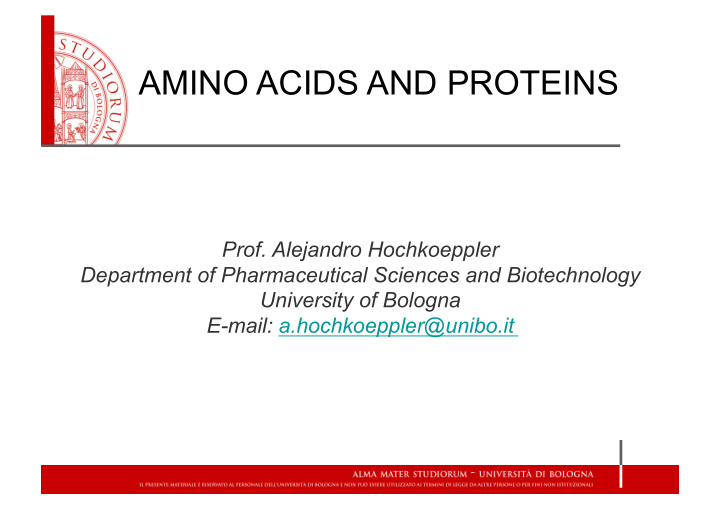



AMINO ACIDS AND PROTEINS Prof. Alejandro Hochkoeppler Department of Pharmaceutical Sciences and Biotechnology University of Bologna E-mail: a.hochkoeppler@unibo.it
AMINO ACIDS AND PROTEINS Composition of an Escherichia coli cell Component ¡ % ¡Wet ¡Mass ¡ Water ¡ 70 ¡ Nucleic ¡Acids ¡ 7 ¡ Proteins ¡ 15 ¡ Lipids ¡ 2 ¡ Polysaccharides ¡ 3 ¡ Amino ¡Acids ¡(Metabolies) ¡ 0.8 ¡ NucleoCdes ¡(Metabolites) ¡ 0.8 ¡ Inorganic ¡Ions ¡ 1 ¡
AMINO ACIDS AND PROTEINS Proteins are composed of α -amino acids There are 20 types of R groups: 20 different amino acids. Alpha carbon is chiral L- and D-amino acids. Proteins are composed of L-amino acids. α Amino acids are classified according to their R-groups. Three major R groups: hydrophobic, charged, polar. To distinguish between L- and D-amino acids we can look along the H-C α axis. The two configurations are mirrored when we look at them together. D-Alanine L-Alanine
AMINO ACIDS AND PROTEINS D-Alanine L-Alanine L-Lysine D-Lysine
AMINO ACIDS AND PROTEINS P G A V Q N L I M R K G F Y W H E D S T C
AMINO ACIDS AND PROTEINS Hydrophobic Amino Acids Val Ala Leu Phe Ile Tyr
AMINO ACIDS AND PROTEINS The size of Amino Acids varies considerably Gly Small Amino Acids Trp Glycine: Molecular Mass 75.07 g Mol -1 Large Amino Acids Tryptophan: Molecular Mass equal to 204.24 g Mol -1
AMINO ACIDS AND PROTEINS Charged Amino Acids Arg Lys Glu Asp
AMINO ACIDS AND PROTEINS Polar Amino Acids Ser Thr Asn Gln
AMINO ACIDS AND PROTEINS Sulfur-containing Histidine: acid-base catalysis Amino Acids His Cys Proline: peculiar α carbon α Met Pro
AMINO ACIDS AND PROTEINS Amino ¡Acid ¡ pKa ¡ Aspartate ¡(D) ¡ 3.90 ¡ D E Glutamate ¡(E) ¡ 4.07 ¡ HisCdine ¡(H) ¡ 6.04 ¡ Tyrosine ¡(Y) ¡ 10.13 ¡ H Y Cysteine ¡(C) ¡ 10.46 ¡ C Lysine ¡(K) ¡ 10.79 ¡ Arginine ¡(R) ¡ 12.48 ¡ R K Only Histidine features a pKa near physiological pH. Cysteine is engaged in disulfide bridges.
AMINO ACIDS AND PROTEINS One strand of DNA is transcribed (5’ to 3’ direction) Messenger RNA (mRNA) mRNA is translated into protein (5’ to 3’ direction) Protein synthesis from N- to C-ter
AMINO ACIDS AND PROTEINS Escherichia coli Rop protein: 63 amino acids The sequence of amino acids (N- to C-ter, left to right) is denoted as “primary structure”. Primary structures can be compared: sequences of proteins are aligned and identity or homology are revealed Secondary structure of Rop protein: two secondary structural elements (alpha helices, H) are present (H1 3 to 28, H2 32 to 56) 3 28 32 56
AMINO ACIDS AND PROTEINS A dehydration reaction leads to the formation of peptide bond: a carboxylate and an amino group are linked into an amide. One acidic function (carboxylate) and one basic function (amino) are lost upon peptide bond formation. The remaining amino and carboxy function are denominated: N- and C-terminus, respectively. By convention the sequence of a peptide (or protein) is written from left to right in the N-ter to C-ter direction.
AMINO ACIDS AND PROTEINS Alpha carbon features sp 3 hybridization. Carbon C’ is sp 2 -hybridized. Amino nitrogen is conjugated with C’ carbon. Peptide unit: alpha carbon i , C’ carbon i , amino nitrogen i+1 , alpha carbon i+1 Due to delocalization of nitrogen doublet, the peptide unit is planar. Rotation around alpha carbon is responsible of protein conformation
AMINO ACIDS AND PROTEINS Rotation of alphaC-amideN: phi angle Rotation of alphaC-C’carbon: psi angle How are phi and psi angles defined?
AMINO ACIDS AND PROTEINS Looking along the amideN-alphaC axis (perpendicular): i – 1 C’ i C’ The i C’ lies to the left of i -1 C’: phi angle is negative
AMINO ACIDS AND PROTEINS Looking along the alphaC-C’ axis: The i + 1 N lies to the left of i N: psi angle is negative
AMINO ACIDS AND PROTEINS The peptide unit in proteins is usually in trans conformation H28 K29 H28 K29 H28 enters to the peptide unit from the back, K29 exits to the front. Steric clash between R groups is avoided in the trans conformation.
AMINO ACIDS AND PROTEINS Native conformation (purple) Altered conformation (green) K29 H28 H28 K29 K29 ϕ angle: 7.7 ϕ angle: -141.8 Native conformaion is in trans, altered conformation is in cis
AMINO ACIDS AND PROTEINS + Lys His cis trans
AMINO ACIDS AND PROTEINS Neighbour amino acids (G27 and I 30). Trans or cis conformation? K29 H28 G27 I30 K29 I30
AMINO ACIDS AND PROTEINS The Pro-X unit features trans or cis configuration. Trans-cis interconversion? D55 P54 P54 D55
AMINO ACIDS AND PROTEINS The Pro-X unit features trans or cis configuration. Trans-cis interconversion? D55 P54
AMINO ACIDS AND PROTEINS The X-Pro unit features trans or cis configuration. Trans-cis interconversion? K53 P54
AMINO ACIDS AND PROTEINS Cleavage of the peptide bond for cis - trans isomerization of Lys-Pro Lys + Pro trans cis
AMINO ACIDS AND PROTEINS Theta subunit DNA Pol-III E. coli Alpha subunit 76 residues DNA Pol-III E. coli 1160 residues 61.22 Angstroms 1 Å = 0.1 nm
AMINO ACIDS AND PROTEINS Beta clamp of DNA Pol-III E. coli : 366 amino acids. Homodimer.
AMINO ACIDS AND PROTEINS F0-F1 ATPase: complex enzyme, membrane-associated (F0).
AMINO ACIDS AND PROTEINS Trypsin An enzyme Tubulin Structural protein IgG1 Binds an antigen
Recommend
More recommend